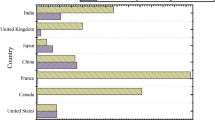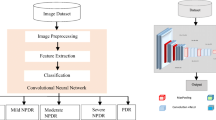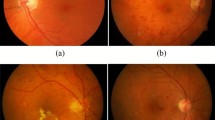Abstract
Diabetic retinopathy screening involves assessment of the retina with attention to a series of indicative features, i.e., blood vessels, optic disk and macula etc. The detection of changes in blood vessel structure and flow due to either vessel narrowing, complete occlusions or neovascularization is of great importance. Blood vessel segmentation is the basic foundation while developing retinal screening systems since vessels serve as one of the main retinal landmark features. This article presents an automated method for enhancement and segmentation of blood vessels in retinal images. We present a method that uses 2-D Gabor wavelet for vessel enhancement due to their ability to enhance directional structures and a new multilayered thresholding technique for accurate vessel segmentation. The strength of proposed segmentation technique is that it performs well for large variations in illumination and even for capturing the thinnest vessels. The system is tested on publicly available retinal images databases of manually labeled images, i.e., DRIVE and STARE. The proposed method for blood vessel segmentation achieves an average accuracy of 94.85% and an average area under the receiver operating characteristic curve of 0.9669. We compare our method with recently published methods and experimental results show that proposed method gives better results.











Similar content being viewed by others
References
Susman EJ, Tsiaras WJ, Soper KA (1982) Diagnosis of diabetic eye disease. JAMA 247:3134–3231
Kanski J (1994) Clinical Opthalmology. Butterworh-Heinmann, London
Bhavsar AR (2002) Diabetic retinopathy, the diabetes eye exam initiative. Minn Med 85:46–47
Younis N, Broadbent DM, Harding SP, Vora JP (2002) Prevalence of diabetic eye disease in patients entering a systematic primary care-based eye screening programme. Diabet Med 19:1014–1021
Sinclair SH, Delvecchio C (2004) The internist’s role in managing diabetic retinopathy: screening for early detection. Cleveland Clin J Med 71:151–159
Cavallereno J, Aiello LM (2005) Emerging trends in ocular telemedicine: the diabetic retinopathy model. J Telemed Telecare 11:163–166
Davis RM, Fowler S, Bellis K, Pocki J, Pakalnis VA, Woldorf A (2003) Telemedicine improves eye examination rates in individuals with diabetes. Diabetes Care 26:2476
Lightman S, Towler H (2003) Diabetic retinopathy. Clin Cornerstone 5:12–21
Martnez-Prez ME, Hughes AD, Thom SA, Bharath AA, Parker KH (1999) Retinal blood vessel segmentation by means of scale-space analysis and region growing. In: Medical image computing and computer-sssisted Intervention MICCAI, pp 90–97
Pinz A , Bernogger S, Datlinger P, Kruger A (1998) Mapping the human retina. IEEE Trans Med Imag 17:606–619
Tsai CL, Stewart CV, Tanenbaum HL, Roysam B (2004) Modelbased method for improving the accuracy and repeatability of estimating vascular bifurcations and crossovers from retinal fundus images. IEEE Trans Inf Technol Biomed 8:122–130
Foracchia M, Grisam E, Ruggeri A (2004) Detection of the optic disc in retinal images by means of a geometrical model of vessel structure. IEEE Trans Med Imag 23:1189–1195
Li H, Chutatape O (2004) Automated feature extraction in color retinal images by a model based Approach. IEEE Trans Biomed Eng 51:246–254
Mendona M, Campilho AJ (2006) Segmentation of Retinal Blood Vessels by Combining the Detection of Centerlines and Morphological Reconstruction. IEEE Trans Med Imag 25:1200–1213
Liu I , Sun Y (1993) Recursive tracking of vascular networks in angiograms based on the detection–deletion scheme. IEEE Trans Med Imag 12:334–341
Zhou L, Rzeszotarski MS, Singerman LJ, Chokreff JM (1994) The detection and quantification of retinopathy using digital angiograms. IEEE Trans Med Imag 13:619–626
Chutatape O, Zheng L, Krishnan SM (1998) Retinal blood vessel detection and tracking by matched Gaussian and Kalman filters. In: 20th Annual International Conference of the IEEE Engineering in Medicine and Biology Society (EMBS98), pp 3144–3149
Tolias YA, Panas SM (1998) A fuzzy vessel tracking algorithm for retinal images based on fuzzy clustering. IEEE Trans Med Imag 17:263–273
Can A, Shen H, Turner JN, Tanenbaum HL, Roysam B (1999) Rapid automated tracing and feature extraction from retinal fundus images using direct exploratory algorithms. IEEE Trans Inf Technol Biomed 3:125–138
Lalonde M, Gagnon L, Boucher M-C (2000) Non-recursive paired tracking for vessel extraction from retinal images. In: Vision Interface, pp 61–68
Staal J, Abramoff MD, Niemeijer M, Viergever MA, van Ginneken B (2004) Ridge-based vessel segmentation in color images of the retina. IEEE Trans Med Imag 23:501–509
McInerney T, Terzopoulos D (2000) T-snakes: Topology adaptive snakes. Med Image Anal 4:73–91
Toledo R, Orriols X, Binefa X, Radeva P, Vitri J, Villanueva J (2000) Tracking of elongated structures using statistical snakes. In: IEEE Computer Society Conference on Computer Vision and Pattern Recognition (CVPR), pp 157–162
Vasilevskiy A, Siddiqi K (2002) Flux maximizing geometric flows. IEEE Trans Pattern Anal Mach Intell 24:1565–1578
Nain D, Yezzi A, Turk G (2004) Vessel segmentation using a shape driven flow. In: Medical image computing and computer-assisted intervention MICCAI, pp 51–59
Chaudhuri S, Chatterjee S, Katz N, Nelson M, Goldbaum M (1989) Detection of blood vessels in retinal images using two dimensional matched filters. IEEE Trans Med Imag 8:263–269
Hoover A, Kouznetsova V, Goldbaum M (2000) Locating blood vessels in retinal images by piecewise threshold probing of a matched filter response. IEEE Trans Med Imag 19:203–211
Soares JVB, Leandro JJG, Cesar RM, Jelinek HF, Cree MJ (2006) Retinal vessel segmentation using the 2-D Gabor wavelet and supervised classification. IEEE Trans on Med Imag 25:1214–1222
Jiang X, Mojon D (2003) Adaptive local thresholding by verificationbased multithreshold probing with application to vessel detection in retinal images. IEEE Trans Pattern Anal Mach Intell 25:131–137
Fraz MM, Basit A, Javed MY (2008) Evaluation of retinal vessel segmentation methodologies based on combination of vessel centerlines and morphological processing. In: IEEE ICET08, pp 232–236
Antoine JP, Carette P, Murenzi R, Piette B (1993) Image analysis with two-dimensional continuous wavelet transform. Signal Process 31:241–272
Gonzalez RC, Woods RE (2002) Digital image processing. 2nd edn. Prentice hall, New Jersey
Author information
Authors and Affiliations
Corresponding author
Rights and permissions
About this article
Cite this article
Akram, M.U., Khan, S.A. Multilayered thresholding-based blood vessel segmentation for screening of diabetic retinopathy. Engineering with Computers 29, 165–173 (2013). https://doi.org/10.1007/s00366-011-0253-7
Received:
Accepted:
Published:
Issue Date:
DOI: https://doi.org/10.1007/s00366-011-0253-7




